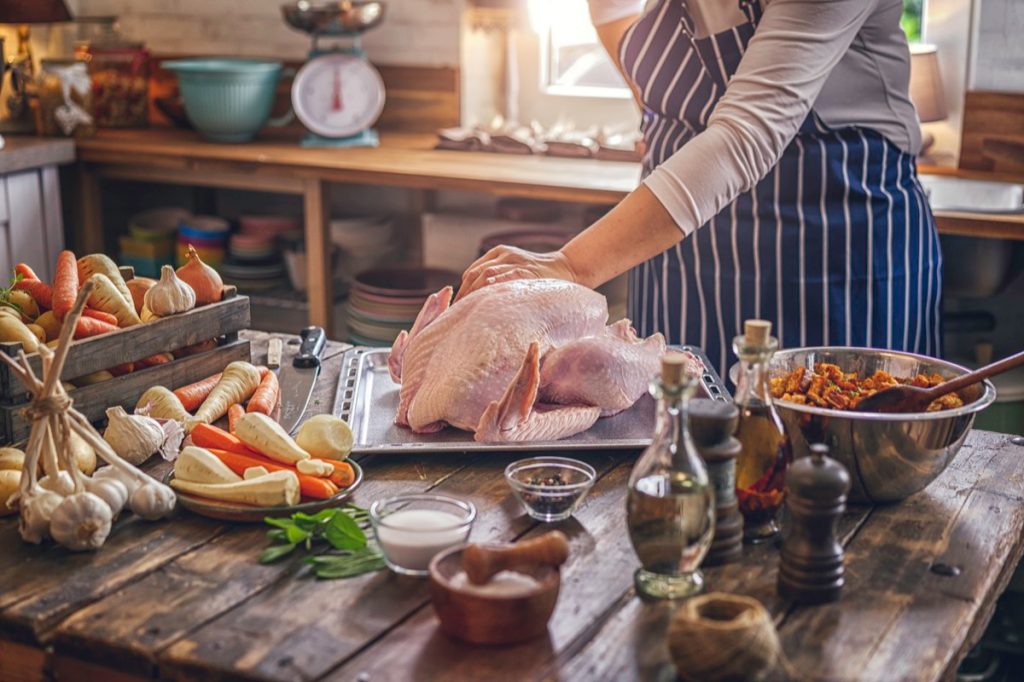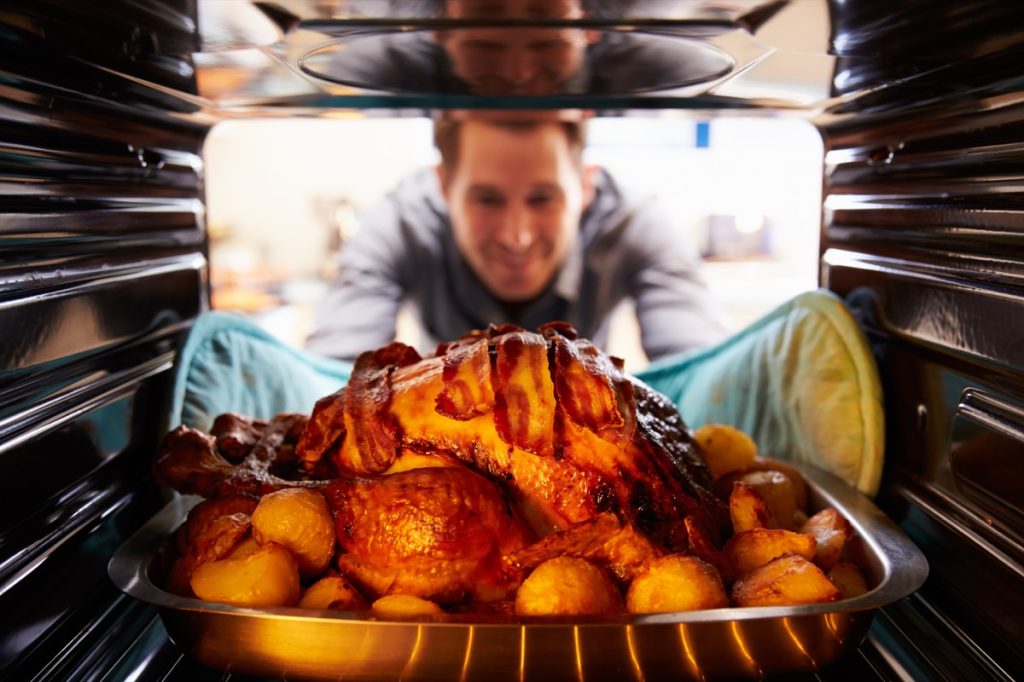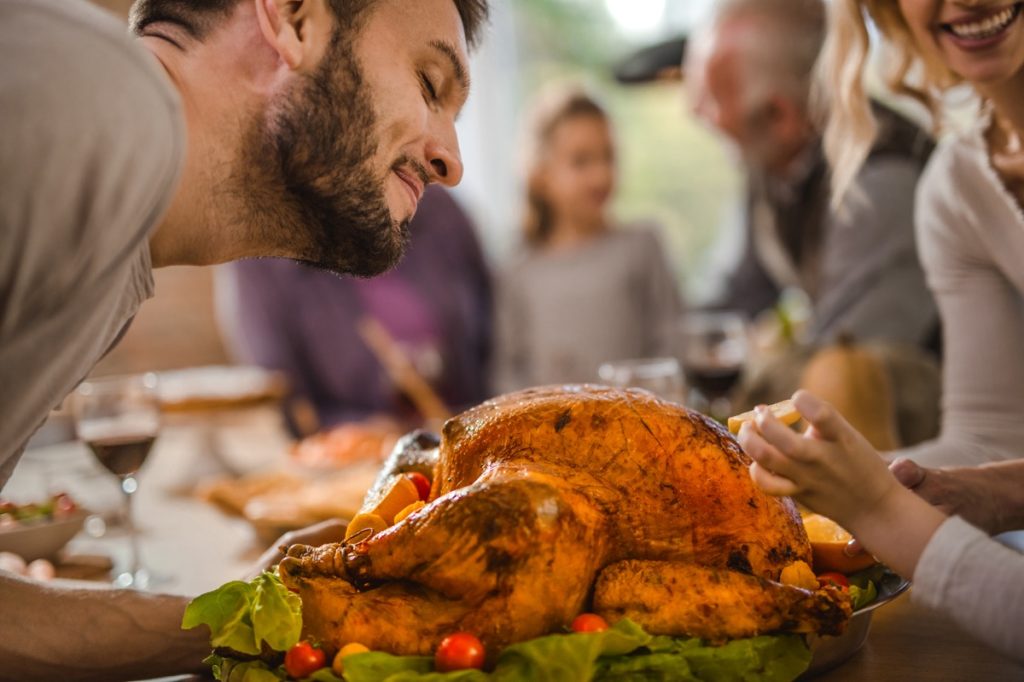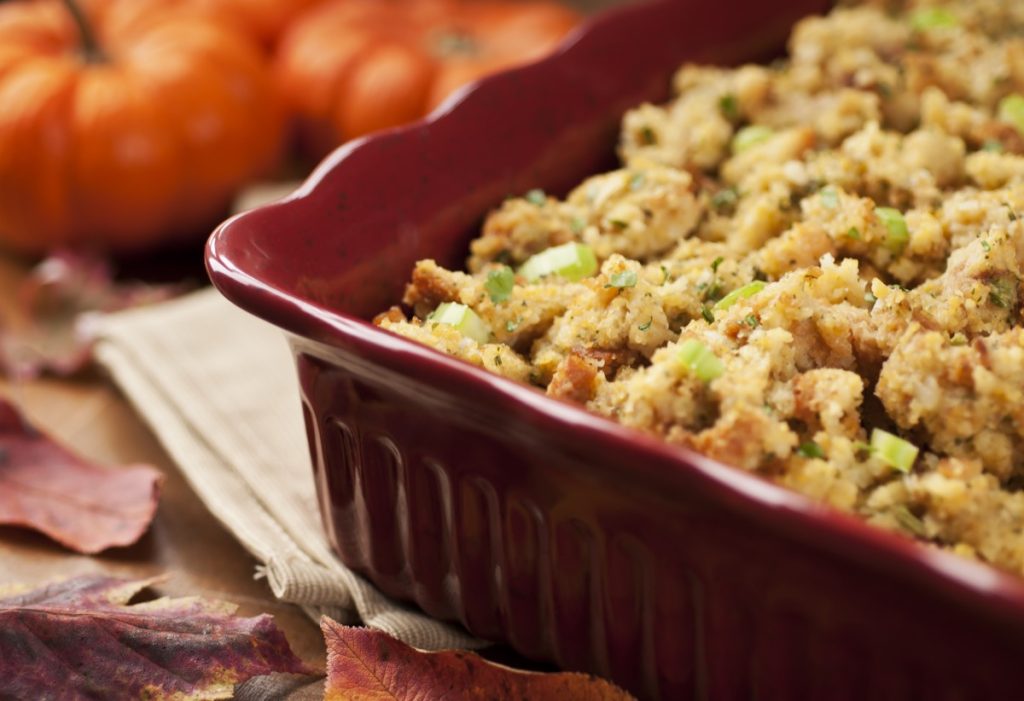Avoiding Thanksgiving Food Poisoning
Few food items cause more meal preparation stress than Thanksgiving turkey. The giant bird can take even seasoned chefs out of their comfort zone when it comes to seasoning, preparing, cooking, and serving the holiday meal hallmark. Most home cooks are simply hoping to avoid mealtime disasters that might ruin the dish in the end by making it too dry or bland—all while worrying about the other sides that have to make their way to the table. But beyond providing a tasty feast, it’s also essential to ensure you’re not going to make people sick. Keeping vital food safety information in mind while preparing and serving your dinner is essential. Read on to see how you can avoid food poisoning on Thanksgiving by tackling your turkey the right way.
READ THIS NEXT: Never Wash These Vegetables Before Eating Them, Experts Warn.

Even for those who aren’t sticklers for tradition, it’s hard to imagine a Thanksgiving feast without a perfectly prepared turkey as the star of the table. But during the excitement and commotion of celebrating, it can sometimes be easy to forget that the popular poultry preparation can be a serious health hazard if you’re not careful. According to the Centers for Disease Control and Prevention (CDC), raw turkey can contain scores of potentially harmful bacteria that can cause food poisoning such as Salmonella, Clostridium perfringens, and Campylobacter, among others.
“We know that outbreaks of foodborne illness can and do happen around Thanksgiving,” Laura Ford, PhD, an epidemiologist in the division of foodborne, waterborne, and environmental diseases at the CDC, told Today.com. “The CDC does not collect data specifically related to holidays, but some foods people enjoy during Thanksgiving can lead to serious foodborne illnesses if the foods aren’t properly handled, cooked, stored, or reheated.”
Accidentally eating the harmful microorganisms can eventually lead to symptoms such as upset stomach, stomach cramps, nausea, vomiting, diarrhea, and fever, according to the agency. Besides being a surefire way to make your holiday memorable for all the wrong reasons, it can also cause even more severe illnesses in young children, the elderly, and those who are immunocompromised.

Even home cooks who are well versed in roasting chickens are likely less familiar with properly preparing poultry items as large as a Thanksgiving turkey. But according to the CDC, the first steps to avoiding food poisoning start well before you even begin cooking by ensuring it’s stored and thawed safely.
It’s best to place any frozen turkeys in the refrigerator in a container to control any drippings, allowing for 24 hours per each four to five pounds of turkey to unfreeze. However, the agency emphasizes that you should never thaw by leaving a frozen bird on your countertop, as the outer areas of the bird can begin to harbor dangerous bacteria even as the center stays ice cold.
Since a Thanksgiving meal has many moving parts, it’s also important to remember that cross-contamination can also be a significant hazard. The CDC suggests using one cutting board for raw turkey and a separate surface for any foods that won’t get cooked, such as vegetables, bread, or cheese. Any surfaces, plates, or utensils that raw turkey or its juices touch should be sanitized with hot soapy water before they’re used again.
And if you’re thinking of washing your turkey before it goes in the oven, think again: According to the CDC, federal agencies have recommended not rinsing poultry since 2005. The added moisture can make it easier for the turkey’s juices to spread around the sink and kitchen, drastically increasing the risk of cross-contamination of surfaces or other dishes.
RELATED:
For more up-to-date information, sign up for our
daily newsletter.

Anyone who’s been in charge of a Thanksgiving meal before is likely familiar with the pressure to not serve a dry turkey during the big meal. But when it comes to avoiding food poisoning, one of the most important steps involves making sure your bird is properly cooked before it gets to the table.
If you’re roasting your turkey in an oven, the CDC says it’s best to set the temperature to at least 325 degrees Fahrenheit and put the bird in a 2-to-2.5-inch deep roasting pan. Even though roasting time will vary based on how big your bird is, it’s considered safe to eat once it’s reached an internal temperature of 165 degrees Fahrenheit. You can check this by inserting a meat thermometer into the thickest part of the breast, where the body and thigh join, and where the body and wing join, making sure to avoid touching any bone. The agency clarifies that completing this step is still important, even if your turkey comes with a pop-up thermometer.

Some home cooks like to prepare stuffing for the table by letting it roast inside the turkey, whether it’s a family tradition or a personal preference. But unfortunately, this can make things more complicated when trying to stay healthy and avoid food poisoning.
“There is a possibility that the stuffing in the center of a turkey, which has come in contact with the raw cavity of the bird, as well as bacteria, will not reach 165 degrees, and the bacteria within won’t die, even though the meat is completely cooked,” Sally Stevens, RDN, tells AllRecipes. “We cook poultry to an internal temperature of 165 degrees because all bacteria die within 15 seconds at that temperature.”
According to the CDC, the safest stuffing preparation method is to make it separate from the bird to avoid any mishaps. But if you choose to combine the two, it’s best to wait until just before the turkey goes into the oven before adding the stuffing. You should then use a food thermometer to ensure that the deepest part of the stuffing reaches 165 degrees. Once you’ve pulled the bird from the oven, the agency suggests waiting an extra 20 minutes before serving to ensure that the stuffing can cook a little longer.
" Conservative News Daily does not always share or support the views and opinions expressed here; they are just those of the writer."
